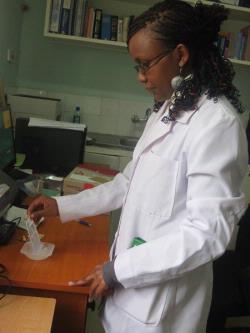
Marya Lieberman, associate professor of chemistry and biochemistry, has collaborated with faculty and students to demonstrate advances in paper analytical devices (PAD) to test for counterfeit drugs. The promising low-tech solution has received broad attention in the scientific community. Lieberman's work was featured this week in Chemical and Engineering News.
This past June, Lieberman presented her findings a workshop in Eldoret, Kenya. With graduate student Abigail Weaver, Lieberman demonstrated the microfluidic devices to hospital officials in Kenya who are continually looking for counterfeit pharmaceuticals but frequently lack the complex testing equipment necessary to confirm a drug’s authenticity. The PADs provide a workable alternative to ordinary laboratory tests because they are affordable, transportable and disposable in environments that lack resources for power-dependent permanent instrumentation.
“We would whip out our paper devices and do tests right there on their desktops,” Lieberman said. “We’re also making a smart material, where information on how to add the reagents is stored in the paper matrix and the test output can be read like a color bar code.” The devices were developed in collaboration with Holly Goodson of the Department of Chemistry and Biochemistry at Notre Dame, Patrick Flynn of the Department of Computer Science and Engineering at Notre Dame and Toni Barstis of the Department of Chemistry and Physics at Saint Mary’s College.
Users can swipe tablets across the paper, which is prepared with different lanes to detect different ingredients and reveal the content of the tablet with a color code. The device can detect both the desired active ingredients in the tablet and the presence of fillers, a common problem in counterfeit drugs in developing countries. Although the PAD is not able to quantify the amount of each material, it distinguished pure and adulterated amoxicillin in the Kenya workshop.
Other researchers in the field first gained broad attention in a paper published by George Whitesides in 2007. Those include Paul Yager at the University of Washington, Seattle; Scott Phillips at Pennsylvania State University; and Richard Crooks at the University of Texas, Austin, whose group uses paper-folding origami to create multi-layered devices. Diagnostics for All (DFA), which holds licenses from the Whitesides lab, is developing a device to reliably measure the levels of two liver enzymes.
Lieberman and Goodson are members of the Eck Institute for Global Health which provided funding for Lieberman’s work in Kenya and awarded a graduate fellowship to Weaver.
Photo: Mercy Maina, a Kenyan pharmacist at the Moi Teaching and Referral Hospital in Eldoret Kenya. In this picture, Mercy is using a paper analytical device to screen a sample of amoxicillin.